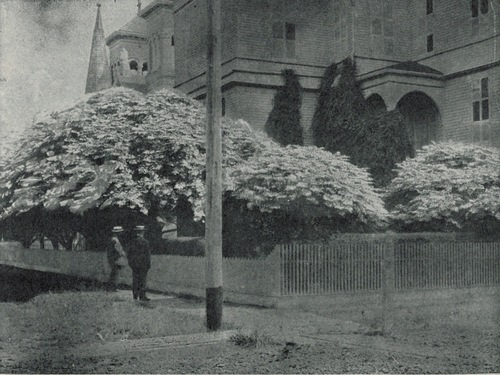.JPG) Umbrella China Trees had a Special Place in Yard
Umbrella China Trees had a Special Place in YardBy Judith Linsley
Special to the Journal
Modern Southeast Texans probably think that summers around here B.A.C. (before air conditioning) were unbearable. The truth is that folks back then had a number of ways to keep themselves relatively cool.
Nowadays, homes are built to keep the cool in and the heat out. Once, though, they were built to allow as much circulation as possible between inside and outside air. Homes built on tall piers allowed the air to flow underneath. High ceilings collected the rising hot air; transoms over doors and double-hung windows that opened at top and bottom allowed that hot air a means of escape. The coolest houses faced south to catch prevailing breezes. Broad porches, often around more than one side of a house, shaded windows while providing a cool outdoor room for sitting.
Of course, once electricity became available, those who could afford it rushed to buy ceiling fans and buzz fans. A buzz fan blowing across a block of ice made a rudimentary air conditioner, if the ice man made deliveries in your neighborhood.
Later, the huge attic fan cooled the whole house by pulling the cooler downstairs air (and outside air as well) up through the attic and out.
Growing things helped keep things cool as well. Green, or "active," shade is much more effective than "passive" shade, such as a canopy or roof. Green grass is much cooler than the equivalent amount of concrete. Morning glories or other vines covering the east or west wide of a porch gave shade in the mornings or evenings, dying down in the winter when the sun was more welcome. Trees were the best shade of all; the air under a mature tree may be as much as 20 degrees cooler than it is in the sun.
One tree that was a fixture in many yards in the early 20th century was the Umbrella China tree, known to nearly everyone in this area as the Chinaberry tree. Chinaberries are native to Asia, but they've been in the U.S. at least since Colonial times, especially in the South. George Washington and Thomas Jefferson planted Chinaberry trees. The fast-growing trees were also used for lining suburban streets.
Chinaberry trees don't get all that big-40 or 50 feet tops-but the "Texas Umbrella China" produces a nice, thick, umbrella-shaped crown that makes for great shade. Topping them makes the canopy even thicker. The down side of the Chinaberry is that it's invasive-it grows anywhere that isn't mowed, much like the Chinese tallow today. And like the tallow, it produces messy and somewhat toxic berries.
But in its glory days, Chinaberries created ideal shady spots to sit and shuck corn, shell peas, or just visit.
In the spring the tree produced fragrant lavender flowers, followed by big green berries that later dried into rock-hard spheres. Boys used the berries for slingshot and peashooter ammunition; girls drilled holes in the hard white core, dyed them, and made Chinaberry necklaces.
The town of China, Texas, took its name from a grove of Chinaberry trees that were planted there. According to historian W.T. Block, when Arthur Stilwell was preparing to bring Dutch immigrants to the town of Nederland, Texas, he chose "Umbrella China trees" to plant in their front lawns.
So where are the Chinaberry trees now? At one time they were a common sight, but when was the last time you saw one in someone's yard? They seem to have disappeared.
Trees are obviously valuable to humans for environmental reasons; but there's an important social connection as well. Thomas Jefferson once wrote, "I never before knew the full value of trees. Under them I breakfast, dine, write, read, and receive my company." He must have been sitting under a Chinaberry tree.
